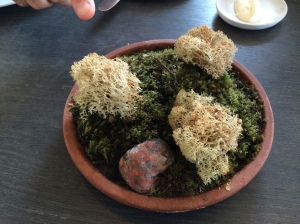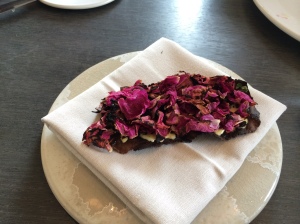How can the supposed best restaurant in the world have only two Michelin stars? The answer provides lessons for business leaders.
First, let’s get the obvious out of the way: Eating at the famous Copenhagen restaurant Noma with some longstanding professional friends is a fortunate privilege I am lucky to have experienced. Writing about the experience sounds like bragging, and I have plenty of hard-working colleagues who make it possible, so I’m not going to wax on about how wonderful it is. Instead, I’d like to explore why the restaurant many consider to be the best in the world has not yet achieved the renowned Michelin Guide’s highest rating?
Contributing to Noma’s reputation as the world’s best is its retaking of top honors by the prestigious San Pellegrino World’s 50 Best Restaurant Awards—an award it has now won four times. Albeit not the 114-year old Michelin Guide, the award is “viewed as the Oscars of fine dining,” suggesting that Noma might indeed “be” the best restaurant in the world, if there is such a thing.
On the other hand, Noma has only two Michelin stars, meaning there are about 100 restaurants in the world Michelin considers better. Opinion on Noma’s inability to get a third Michelin star ranges from outrage to Michelin’s own sanguine opinion on the matter: “It will happen one day, I’m sure. It’s a very good two-star restaurant and sits easily in the guide,” says Rebecca Burr, editor-in-chief of the guide.
The Michelin Guide was founded in 1900 as a way to encourage driving and thus demand for tires. The original guide contained useful information such as maps and—surprise, surprise—how to change a tire. Professional reviewers visit—always anonymously—and rate on a three star system that is essentially based on how much of a detour the restaurant is worth taking (remember, it’s a tire company): one star if you’re already in that town; two stars, well, that’s worth a detour; and three stars makes for a worthy destination unto itself. Keep in mind, this is not a movie rating system. Godzilla gets a 73% rating on RottenTomatoes.com and thus a red tomato, but it would surely not get a single Michelin star—only about 2,000 restaurants worldwide have any Michelin stars.
Okay, so back to Noma. Best restaurant in the world by many accounts, but only two Michelin stars. Why? Here’s how our evening unfolded…
When we first arrived at the unassuming restaurant that Noma is, we were welcomed outside the front door by one of the staff and again once inside by no small gathering of Noma staff—one great big family-size welcome if you will. We were then shown to a relatively simple and unadorned wood table. Wait, no linens? No clusters of silverware and empty glasses in anticipation of the courses and wine servings to come? Nope. I remember recalling an upscale pizza place I enjoy taking my family—yes I said upscale, but in respect to pizza places, not supposedly the best restaurant in the world.
Next came wet towels to wash our hands with, along with the explanation that we will be eating much of the meal with our hands, family style. Eating with our hands? Family style? Perhaps my pizza place analogy wasn’t far off after all. After selecting preferences for juice or wine, the 23-course meal began. In reasonably rapid succession, though never more than two at any one time, course after course appears. First the “appetizer” series such as “Nordic coconut,” “Moss and cep, “Pickled and smoked quails egg,” “Flatbread with wild roses,” and “Burnt leek and cod roe,” followed by “entrées” such as “Beef tartar” with ants and “Turbot and nasturtium.” Then the “desserts” like “Rhubarb and sorrel” and “Crème fraiche and Spanish chervil” followed by the “sweets”—the desserts were apparently not sweet—such as “Aronia berries and söl.” So the evening went. The food was terrific, sometimes even spectacular, and often visually worthy of “food selfies” such as those my tablemates took…
Each course was delivered to the six of us by a few servers—in synchronized fashion as you’d expect from any fine restaurant—with an additional person there to explain that course—the “presenter” if you will. Each new course seemed to bring us different servers and presenters. Instead of a designated waiter for our table, it seemed the entire staff came to our table either delivering or explaining the food. We were eating family style, and they were serving family style. Nice.
Eating at Noma naturally entails talking about the meal with your tablemates. Someone raised the observation of Noma’s top rating yet only two Michelin stars, which led to many observations on why that might be the case. Someone noticed that when you went to the washroom, the staff did nothing with your napkin. Some highfalutin restaurants fold your napkin and place it in the proper place, if not replace it entirely (not very conservation-minded when you think about it). Not Noma: Where and how you leave it is where you find it. Fine with me.
Another thing I noticed: They rarely changed the plates or silverware. Twenty-three courses at some high-end restaurants might mean 23 plates and 23 sets of silverware. At Noma, just a couple of changes: I only recall between apps and entrées and again before desserts. To keep your plate clean, a server occasionally wipes it with a towel. I wonder how toweling off your plate was perceived by the anonymous Michelin reviewer?
The Noma staff also has some levity. When one of the entrée dishes was placed, as the presenter started to explain, “This turbot…” he was interrupted by one of the servers, with the quip: “These are mushrooms from Zimbabwe.” Clearly it was not a mushroom dish and doubtful the turbot was from Zimbabwe, so we all laughed aloud, including the presenter. It was subtle but important for setting the tone: The staff wasn’t taking itself too seriously and neither should we; they were there to have fun, so we should too. I was trying to imagine dining at a Michelin three-star restaurant I know in New York City and a server interrupting with a fabricated description intended to make everyone laugh—it would never happen.
All of this began to add up to why Noma did not have three Michelin stars. How could it? It does not even try to meet the very high service expectations three-star restaurants are known for. And that’s the brilliance of it. I’ve often heard Noma compared to Alinea, considered by many to be America’s best restaurant. But whereas Alinea’s dishes are so technical chef Grant Achatz has to have a Chicago mechanical engineering company invent machines so he can prepare them, Noma’s dishes feel as if they could have been prepared “in a barn” from ingredients “found in the field” as someone at my table suggested. Do not get me wrong: Alinea is terrific, possibly more innovative and maybe even better food-wise, but eating at Alinea will never be considered relaxing or simple.
Toward the end of the evening, we asked the Noma staffer who had seemingly settled into being our official host, “Why doesn’t Noma have three stars?” His answer could be succinctly stated as this: “Because we don’t want to.” Well, maybe that’s not quite fair. He explained that ratings matter and they would be honored to have the third star, but they don’t want to change what they do just to achieve it. While they may not want all the linens or the constant plate and silverware change outs, what it seems they really don’t want is all the pretense and stuffiness that might go with trying to achieve service perfection. They want to have fun and they want it to be relaxed—for their patrons—but I sensed first most for themselves. It is their own work environment, after all—their own culture really—that they are protecting.
At most high-end restaurants there are two sides of the swinging door: the kitchen side, where the real culture of the establishment exists; and then the dining side, where tuxedos are pulled tight and every nuance of fine dining is adhered to with surgical precision. Therein lies the great innovation, or perhaps contradiction, that is Noma: Remarkable food—with farm-to-table simplicity but as sophisticated as any in the world—delivered in a comfortably relaxed and friendly environment that depicts exactly the way the staff wants to work, regardless of whether they are in the kitchen or the dining room.
Noma provides an important lesson for business leaders. Company culture used to be something locked up behind closed doors at headquarters and how customers were serviced was managed with process and procedures, just like the façade servers create at fine dining establishments. Nowadays, culture is out in the open for everyone to see, and process and procedures are harder to instill with today’s mobile workforce. Companies need their associates to grasp the company’s purpose and how that translates to servicing clients much more quickly and without much if any formal training. It is culture that makes this possible. Hiring for the right culture fit is critical, of course, but the culture employees experience on the job dramatically shapes the way they interact with customers. Essentially, culture is more than just trying to make the office a fun place to work and has become something customers see. Those that get it right will create competitive advantage.
Leaders need to also remember to be careful what they pursue. A business-minded Noma might modify what it was doing in an effort to gain that third star, only to lose what made it the best restaurant in the world. The secret to happy customers: Have happy employees who enjoy what they do. My memory of the food will fade over time (except maybe for the beef with ants), but the one thing that will make me want to go back will be to enjoy how they turn a remarkably innovative menu into a wonderfully relaxed dining experience—provided they never get that third Michelin star. Whether or not I am lucky enough to ever go back, thank you Noma for a terrific example of how culture drives success.








